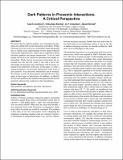Dark patterns in proxemic interactions : a critical perspective
Abstract
Proxemics theory explains peoples' use of interpersonal distances to mediate their social interactions with others. Within Ubicomp, proxemic interaction researchers argue that people have a similar social understanding of their spatial relations with nearby digital devices, which can be exploited to better facilitate seamless and natural interactions. To do so, both people and devices are tracked to determine their spatial relationships. While interest in proxemic interactions has increased over the last few years, it also has a dark side: knowledge of proxemics may (and likely will) be easily exploited to the detriment of the user. In this paper, we offer a critical perspective on proxemic interactions in the form of dark patterns: ways proxemic interactions can be misused. We discuss a series of these patterns and describe how they apply to these types of interactions. In addition, we identify several root problems that underlie these patterns and discuss potential solutions that could lower their harmfulness.
Citation
Greenberg , S , Boring , S , Vermeulen , J & Dostal , J 2014 , Dark patterns in proxemic interactions : a critical perspective . in Proceedings of the 2014 Conference on Designing Interactive Systems : Processes, Practices, Methods, and Techniques, DIS . ACM , New York , pp. 523-532 . https://doi.org/10.1145/2598510.2598541
Publication
Proceedings of the 2014 Conference on Designing Interactive Systems
Type
Conference item
Description
Additional grant funding by NSERC, SMART and AITFCollections
Items in the St Andrews Research Repository are protected by copyright, with all rights reserved, unless otherwise indicated.

